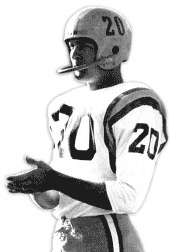
Billy Cannon
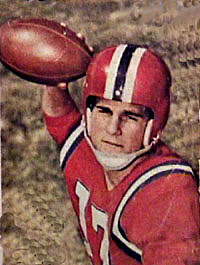
Don Meredith
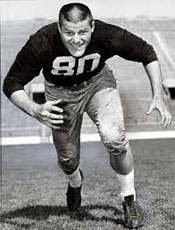
Monty Stickles
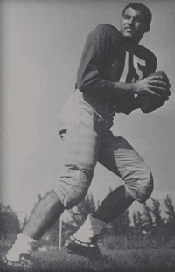
Fran Curci
|
Imagine you're starting a new pro football league. You have eight franchises lined up. So you conduct a draft of college players. Then, after the draft, one of the owners reneges and joins the rival league. What do you do with the players drafted by the treacherous franchise? You'd like to transfer them to the replacement club, but the other seven clubs greedily sign players from the defunct team.
Think this is a hypothetical situation? Well, think again. The American Football League had to deal with such a mess in 1959-60. The fledgling league, the brainchild of Lamar Hunt and Bud Adams, conducted its first draft on November 22, 1959. Since every team started from scratch, 33 rounds were conducted. Each team had "territorial rights" to players from its general region who might draw fans. So the first player chosen by each team was its "bonus" pick.
| Boston Patriots |
Gerhard Schwedes, HB Syracuse |
| Buffalo Bills |
Richie Lucas, QB Penn State |
| Dallas Texans |
Don Meredith, QB SMU |
| Denver Broncos |
Roger LeClerc, C Trinity |
| Houston Oilers |
Billy Cannon, HB LSU |
| Los Angeles Chargers |
Monty Stickles, E Notre Dame |
| New York Titans |
George Izo, QB Notre Dame |
| Minneapolis |
Dale Hackbart, QB Wisconsin |
After the first round, the draft order was determined by lot and position. So teams selected backs first, then linemen. The league conducted an additional 20 rounds on December 2. On January 1, the league staged a coup when Oilers' owner Adams signed Heisman winner Cannon under the goal posts after the Sugar Bowl. The owners also cooperated by giving up the rights to a draftee if he wanted to play for another AFL team. For example, Ron Mix from USC, drafted by the Patriots, signed with the hometown Chargers.
Then on January 27, a setback. Minneapolis owner Max Winter, wooed by the NFL since November, announced he was accepting an NFL expansion franchise. (The NFL also offered Hunt the Dallas franchise he had been seeking, but he wouldn't betray the other owners he had recruited for the AFL.) On January 30, the AFL replaced Minneapolis with the Oakland Raiders.
Of the eight bonus players listed above, Meredith signed with the Dallas Cowboys while Stickles went with the 49ers. Those who did sign with the AFL were busts except for Cannon, who helped the Oilers win the first AFL championship.
Here are some other players selected in the first AFL draft.
- Max Fugler, C/LB LSU – Patriots
- Larry Wilson, HB Utah – Bills (Hall of Fame S with St. Louis Cardinals)
- Pat Dye, T/G Georgia – Patriots (Auburn head coach 1981-92)
- Gail Codgill, E Washington State – Texans (1960 NFL Rookie of Year with Lions)
- Warren Rabb, QB LSU – Texans (QB of Tigers' 1958 national championship team)
- Johnny Robinson, HB/DB LSU – Texans (member of the all-time AFL team as S for Texans/KC Chiefs)
- Mel Branch, DT LSU – Broncos (four-time All-Star with Texans)
- Dick Bass, HB Pacific – Oilers (All-Pro RB with LA Rams)
- Paul Maguire, E Citadel – Chargers (long-time announcer currently with ESPN/ABC)
- Jim Marshall, DT Ohio State – Oilers (set NFL consecutive games record playing for Vikings)
- Jackie Burkett, C Auburn – Titans (played 10 seasons for Colts)
- Prentice Gautt, FB Oklahoma – Titans (first black player at OU; played 7 years in NFL)
- Don Perkins, HB New Mexico – Titans (6-time Pro Bowler for Cowboys)
- Maxie Baughan, C Georgia Tech – Raiders (9-time Pro Bowler for Eagles, Rams, Redskins)
- Fran Curci, QB Miami (FL) – Raiders (head coach at Kentucky 1973-81)
- Abner Haynes, HB N. Texas St. – Raiders (AFL's first Player of the Year with Texans)
- Jim Otto, C Miami (FL) – Raiders (Hall of Fame after 15 seasons in Oakland)
- Johnny Brewer, E Ole Miss – Raiders (played 10 years in NFL)
- Billy Brewer, QB Ole Miss – Patriots (Ole Miss head coach 1983-93)
|
|

Jim Kelly |
On September 18, 1992, the San Francisco 49ers host the defending AFC champion Buffalo Bills.
- The 49ers set a franchise record with 598 yards of total of offense. However, they lose the game 34-31.
- Jim Kelly becomes the first Bills QB to pass for more than 400 yd (22 of 33 for 403).
- For the third time in league history, opposing passers throw for more than 400 yards as Steve Young gashes the Buffalo D for 447 on 26 completions.
- Both teams boast a pair of receivers who each gain more than 100 yd: Andre Reed/Pete Metzelaars for Buffalo and John Taylor/Mike Sherrard for the 49ers.
- The 1,086 total yards is the fourth highest in NFL history.
- For the first time in league history, neither team punts the ball.
|

Steve Young |
|
On September 24, 1967, Jim Bakken of the St. Louis Cardinals became the first kicker to boot seven FGs in a game.
- He did it in a 28-14 victory over the Pittsburgh Steelers at Forbes Field, Pittsburgh.
- Bakken also missed two FGs during the contest.
- He finished that season in the top two in successful FGs for the fourth year in a row.
- Jim led the NFL in FG% in 1967 as he had in 1965. In both those seasons, he made the Pro Bowl.
- He ended with 1,380 points in his 17-year career, which was spent entirely with the Cardinals.
|
|
|
According to the University of Pennsylvania, its 1911 football team was the first to wear numbers on their jerseys.
- For the 1916 season, the NCAA recommended that each player have a number on the back of his jersey.
- In 1937, the NCAA required football players to wear a number on both the front and back of their jerseys. Numbers on the front must be 6" high while the numerals on the back were 10".
- For 1967, numbering was modified according to position, with offensive players ineligible to receive forward passes required to wear numbers in the 50-79 range.
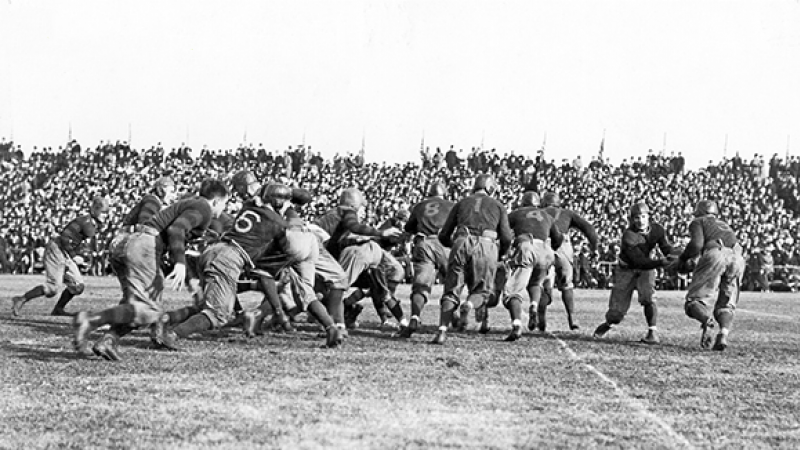
Action in 1917 Rose Bowl
with players having numbers on the backs of their jerseys |
Play-by-Play Transmission; Little Brown Jug
According to the University of Michigan Athletics History website, the first transmission of the progress of a football game over a distance occurred in 1903.
- A UM student, Floyd (Jack) Mattice, the Athletic Association, and the Bell Telephone Company collaborated to bring Wolverine fans in Ann Arbor a "live" account of the Minnesota game played on October 31 in Minneapolis.
- In Minneapolis, Bell engineers erected a wooden tower 40 ft high at the 55-yard line (midfield on the 110-yd field of the time). Mattice climbed to the wooden booth at the top of the tower and donned a headset. When he spoke into the transmitter, he was answered by a professor speaking from University Hall on the UM campus in Ann Arbor.
- The telephone company ran special phone lines to the University Hall Auditorium. (The Bell company also connected several other cities into the same transmission.) 3,000 people paid 25 cents each to hear Mattice's description of the game. However, they didn't hear it directly. The Bell engineers placed 10 telephones on 10 tables backstage in University Hall. Ten students, who knew football and the opposing teams, sat at the tables in numbered order.
- Following the plays through binoculars, Mattice described the progress of the game from his vantage point high above the 20,000 spectators. The first student listened on telephone #1 to as much of Mattice's description as he could remember, dropped the receiver and rushed to the stage. By megaphone he told the crowd what he had heard. Meanwhile, the student at the second telephone picked up more of Mattice's play-and-play and in turn rushed to the stage to give his account. Then the third man picked up where the second had left off. In this manner, the 10 students dashed back and forth to relay the description.
- The course of the game was also charted on a large diagram of a football field on the auditorium stage. As play progressed, a marker charted the position of the ball.
- On Thanksgiving, the same system was employed when Michigan visited the University of Chicago. Lacking a tower, Mattice described the action as he walked along the sideline.
- The 1903 Michigan-Minnesota clash also inaugurated the Little Brown Jug tradition. Fearful that Minnesota would contaminate the drinking water, Wolverine Coach Fielding Yost brought Ann Arbor water in a jug for his team. After UM led 6-0 most of the game, the Gophers scored late to tie. When the crowd stormed the field, the officials ended the contest. The visiting squad exited so quickly that they forgot their water jug. The Minnesota manager found it and offered it as the prize for the next year's game. The jug, later painted brown, has been awarded in the rivalry ever since.
|

Floyd Mattice

University Hall, Michigan
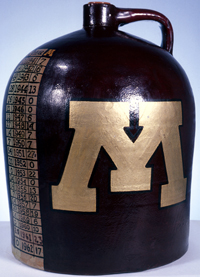
Little Brown Jug |
|
The Liberty Bowl began in Philadelphia after the 1959 season. Penn State defeated Alabama 7-0 before 38,000 in frigid conditions at 100,000-seat Municipal Stadium. Inhospitable weather plagued the game for the next four years, holding down the crowds and threatening the bowl's future. The 1963 game between Mississippi State and North Carolina State drew fewer than 10,000 fans, putting bowl founder A. F. "Bud" Dudley over $40,000 in the hole. Because it was the only bowl game played in the Northeast, writers referred to it as the "Deep Freeze Bowl," the "Masochist Bowl" or the "You're-Out-Of-Your-Mind Bowl."
As a result, the 1964 game was moved to the Atlantic City Convention Hall, thus becoming the first major college game played indoors. (Freezing weather caused the 1932 NFL championship game to be played in Chicago Stadium, an indoor arena despite its name.) In addition to solving Dudley's attendance problems, the Atlantic City businessmen who guaranteed him $25,000 hoped to spark their city's sagging economy. Hosting the Democratic National Convention earlier that year had been another step in their plan. Of course, the jewel of the city's tourism business was the annual Miss America pageant in September in the Convention Hall.
|

Liberty Bowl founder "Bud" Dudley |
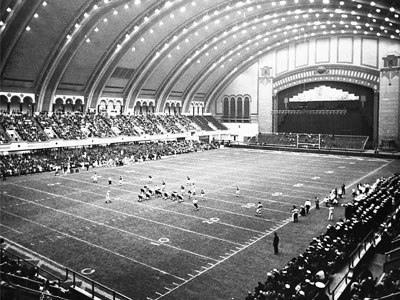 1964 Liberty Bowl in the Atlantic City Convention Hall
1964 Liberty Bowl in the Atlantic City Convention HallSince AstroTurf was still in development, finding a playing surface provided the biggest challenge to staging the game. A four-inch grass surface was installed atop burlap bags to provide a 2-inch cushion. To justify the expense of keeping lights on so that the grass wouldn't die, ten high school and small college games were held on the field. However, the wear and tear wore down the sod to the cement underneath. The entire process cost $16,000. By the time Utah and West Virginia took the field for the 6th Annual Liberty Bowl, the playing surface "was hard as a rock," according to WV G Donnie Young.
The indoor contest required other modifications.
- The end zones were only eight yards deep instead of ten.
- The teams had to walk up on the stage to go to their locker rooms, one team exiting left, the other stage right.
- Actually, "locker rooms" didn't describe the space provided the teams. "There was no place to even hang your clothes," according to WV WR Bob Dunlevy.
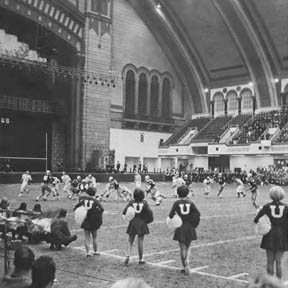 |
Dudley persuaded ABC to televise the game on 210 stations for a record fee of $95,000. The network even promised to send its top announcing team of Curt Gowdy, Paul Christman, and Jim McKay. ABC had no problem with the selection of West Virginia, champions of the Southern Conference. However, when the bowl committee voted to invite Villanova, ABC threatened to cancel its broadcast. Not only was Villanova not a major football school, but the game would hold no attraction for viewers outside the PA-WV area. Instead, the network pushed 8-2 Utah, champions of the Western Conference. The Utes justified their selection by whacking the Mountaineers 32-6 in a dull game. The MVP was Utah QB Ernest Allen.
Although the game attracted only 6,059, Dudley made $10,000 because of Atlantic City's guarantee and tv revenue. Nevertheless, he decided to take his game to other venues. He staged the 1965 Liberty Bowl in Memphis, with Ole Miss defeating Auburn 13-7 before 38,000. As a result, Dudley said, "After Memphis, I never got to the other cities." The bowl remains in The River City to this day. |
Reference: "Unique Game," John Antonik, MSNsportsNET.com
|
|
Game and Student Section
The first college football game occurred on November 6, 1869, in New Brunswick NJ. Half the crowd of 100 were Rutgers students watching their heroes battle the visitors from Princeton, which was (and is) only 20 miles away. Rutgers students, including many of the players, wore scarlet scarves wrapped around their heads like turbans. Most spectators sat on a low wooden fence alongside the field. 25-man teams played the game, which was really a slight variation of rugby.
Yearning to avenge a 40-2 baseball shellacking at the hands of Princeton, Rutgers challenged their rivals to three "football" games. Rutgers prevailed, 6-4, in the first contest. Then Princeton evened the score on their grounds. However, the third game was never played, as both faculties complained that the games were interfering with student studies.
A foretaste of that faculty reaction occurred during the first contest. Several players crashed into the wooden fence, evoking laughter and cheers from the students perched on it. At that point, a Rutgers professor stood up, waved his umbrella at the two teams, and roared: "You will come to no Christian end!"
Read more about the first game.
Reference: Football Feuds: The Greatest College Football Rivalries, Ken Rappoport & Barry Wilner
|
|
Sunday, September 5, 1937: The NFL season opens with the Philadelphia Eagles playing the Pittsburgh Pirates at Forbes Field. It is the first game of the Pirates' new player-coach, John Victor McNally or "Johnny Blood" as he was known professionally. The game was played in "perfect weather" before 8,588 fans.
When the Eagles scored in Q4 to tie the game at 14-14, "Thin Man" Blood the coach told Blood the player to take over the game. So he returned the kickoff 92 yd for a TD. Shortly afterward, Johnny snatched a 44-yd pass from QB Max Fiske for the clinching score in the 27-14 triumph.
The 34-yr old Blood had played for the Green Bay Packers seven of the eight preceding seasons. He would play sparingly in 1937 as the Pirates finished a disappointing 4-7 after recording their first non-losing season (6-6) in franchise history in '36 under Joe Bach. Bach left to return to college coaching at Niagara.
|
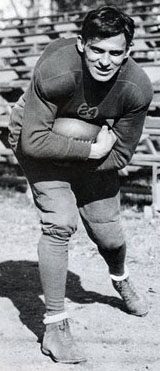 Johnny Blood |
|
In 1952, the NCAA voted 161-7 to give control of telecasts of football games to a TV committee and prohibited any school from scheduling its own telecasts.
- After receiving bids for the telecast package, the committee awarded the contract to NBC, which bid $1,144,000. NBC also promised to create a production unit solely for the telecast of college football.
- General Motors signed a contract with NBC to sponsor the telecasts.
The first NCAA national telecast schedule called for one game each Saturday as follows.
- September 20: TCU @ Kansas
- September 27: Princeton @ Columbia
- October 4: Michigan @ Stanford
- October 11: Texas A&M @ Michigan State
- October 18: Cornell @ Yale
- October 25: Purdue @ Illinois
- November 1: Ohio State @ Northwestern
- November 8: Oklahoma @ Notre Dame
- Novemer 15: Alabama @ Georgia Tech
- November 22: USC @ UCLA
- November 29: Army vs. Navy @Philadelphia
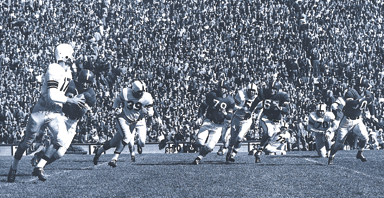 Action from 1952 Michigan State-Texas A&M Game,
Action from 1952 Michigan State-Texas A&M Game,
the nationally-televised game on October 11Games would be televised only if the competing schools agreed. No team could be televised more than once. However, that prohibition didn't apply to conferences, some of which were more amenable to tv than others. Six of the Big Ten teams appeared on the slate. Also included were two games from the Ivy League, still considered a major conference in 1952.
In line with the NCAA's objective of giving TV exposure to smaller schools, NBC allowed its stations to substitute a local game on at least one Saturday. As a result, 51 different teams appeared on TV during the 1952 season.
The national telecasts drew huge audiences. The opening game, carried on 63 stations, gathered a 61.8% audience share. The final game, Army-Navy, achieved an incredible 75% share of sets in use. However, the NCAA continued to be concerned about the continued downward trend in attendance at football games. Members were concerned that telecasts of games nationally hurt live attendance at not only the televised games but at other games in areas where the telecasts were aired. div>
Reference: NCAA: The Voice of College Sports, Jack Falla
|
|
Nickel Defense
October 22, 1961: The 4-1 San Francisco 49ers with their high-powered spread or "shotgun" formation come to Wrigley Field to face the 3-2 Chicago Bears. The visitors, who scored 35+ points in each of their four wins, rotate three QBs: John Brodie, Billy Kilmer, and Bob Waters. Papa Bear George Halas entrusts the task of stopping the shotgun to his D coach Clark Shaughnessy and secondary coach George Allen. They create a new alignment to combat SF's passing attack.
- When Brodie enters the game, Shaugnessy deploys five DBs. Additionally, one or both outside LBs move inside the O tackles, and MLB/signal-caller Bill George gets over the C.
- Amazingly, Chicago shuts out the 49ers 31-0, holding them to six first downs and only 128 yd. The QB troika completes only 5-of-18. Chicago gains six turnovers, including 3 INTs.
- "It was a great effort, our greatest in years," says Halas. "But give a lot of credit to Clark Shaughnessy and Bill George. Clark discarded all the defenses used against the T-formation and resorted to the basic fundamentals used against the double wing of years ago. We varied from a five-man line to six and sometimes seven. Other teams apparently didn't think you could successfully reddog against the shotgun. But we proved it can be done, and we did it by using our linebackers in a rotating pattern."
- The O star for the home team is rookie TE Mike Ditka with 15 catches for 337 yd from QB Billy Wade. Chicago also controls the clock with 35 rushes for 149 yd.
- SF coach Red Hickey isn't particularly gracious in defeat. "That was the worst game
we've played. We've hit different defenses along the way and what the Bears used wasn't especially new and it didn't have us confused. But the inside positioning of their men made the difference and the play of Bill George was really troublesome. It wasn't the formations that beat us, but it was blocking and fundamentals. They out-smarted, outcoached, out-blocked and outtackled us. The Bears aren't that good and we aren't that bad. They were ready mentally and we weren't."
The 4-2-5 D that Shaugnessy employed was given the name "Nickel" by Allen because, he said, it "wasn't worth a nickel." It is still a staple in today's pass-happy college and pro game.
Footnote: The Niners got revenge when the Bears came to the West Coast on November 19. Hickey and his staff adjusted to what they had seen in October because they tromped the visitors 41-21. However, they finish 7-6-1, a half game behind the 8-6 Bears and 3.5 behind Vince Lombardi's NFL Champion Packers.
|
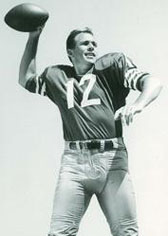 John Brodie
John Brodie
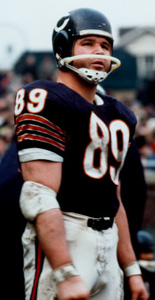
Mike Ditka
|
|
|
CONTENTS
AFL Draft
No Punts
Seven FGs in a Game
Jersey Numbers
Play-by-Play Transmission;
Little Brown Jug
Indoor Major College Game
Game and Student Section
New Pittsburgh Coach
NCAA TV Schedule
Nickel Defense
Football Firsts – I
Football Firsts – II
Football Firsts – IV
Football Magazine
Golden Rankings Home
Top of This Page
|